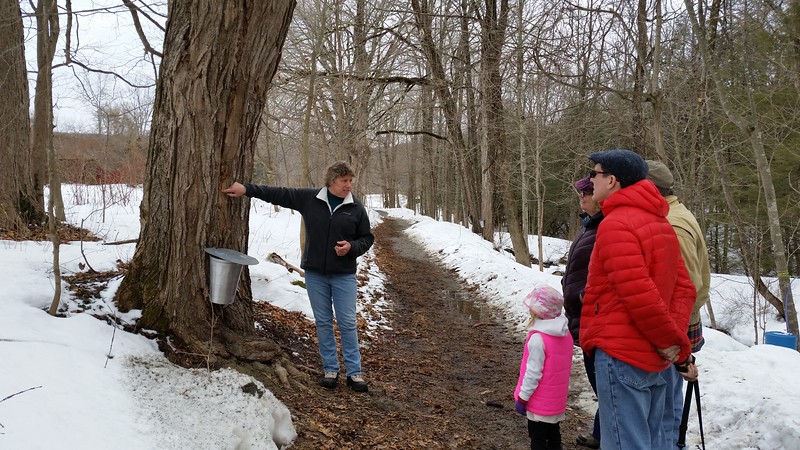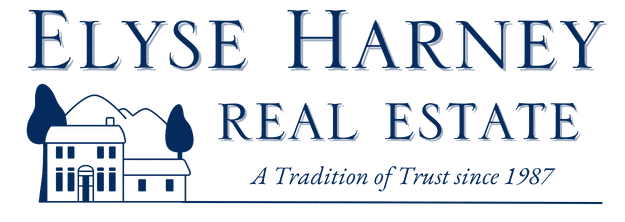400 enjoy sweet hint of spring: MapleFest in Sharon
By N.F. Ambery, Special to The Register Citizen

SHARON, Connecticut
It was a sweet time: There were taps on the trees, sap in the buckets and tours on the trails.
The Sharon Audubon Society held its annual MapleFest Saturday at the Sharon Audubon Center’s grounds on Cornwall Bridge Road. Group tours were given to about 400 people throughout the day of the Center’s sap-collecting operations along its trails with stops at a sugarhouse and at a re-creation of early Native American maple syrup-making methods. Volunteer Stacey Dodge led 45-minute tours in the afternoon, explaining the nuts and bolts of sap-collecting along the maple trails. The previous evening and that morning had brought light snow, so in the 41-degree weather that afternoon, the Center’s trails were soggy and sported many mud puddles for children to splash in. Stopping at 20- to 25-foot sugar maple trees that had a spigot and metal canisters attached to them, Dodge explained the “Rule of 40” when it comes to maple syrup making. During ideal sap-collection conditions, the temperature should be at least 40 degrees on the day following a cold night. A maple tree can only be tapped for sap after it reaches 40 years of age (and must measure 10 inches in diameter).
Moreover, Dodge added that every 40 gallons of sap collected will yield one gallon of maple syrup after boiled. About 300 trees in total are tapped, some being gravity-tapped with a hose system that pools the trees’ sap into collective basins. Along the maple trail, Dodge gave children a peek under the metal lids for a look at the watery sap, which sometimes had ice or a leaf with it in the buckets. Dodge pointed out how to tell if a maple is ideal for sugaring during the winter. “By the bark’s orange color,” she said. “We call it the tree’s ‘orange underwear.’” Dodge also showed a maple tree that had been struck by lightning four years ago. The tree, which sported a jagged split on its top, was initially presumed to have died from the experience. “But it kept producing sap,” Dodge said. “Years later, it still is.”
Center Director Sean Grace, who was on hand during a concurrent tour, said, “It’s good to have folks have the opportunity to see how maple syrup is produced. It’s wonderful for kids. You go through the whole process and you taste the maple syrup. It’s a nice excuse to be in the woods. It’s a nice, different way to spend a day.” Grace said the severe winter has posed challenges to the sugaring operation. “This winter has had lots of cold nights. Tapping is temperature-dependent. The sap is nine percent sugar, and the runs have been marginal compared to other years.” Grace added, “There have been days where there is 3 feet of snow. You have to wear snowshoes or cross-country skis in order to collect the sap. It is truly a labor of love.”
The next stop on the tour was the center’s on-site sugaring operations. Education Program Manager Wendy Miller was on hand at the “sugar house” to show participants the boiling machine that reduces gallons of sap to maple syrup. Amid clouds of sweet-smelling steam arising from the machine, Miller demonstrated methods to determine if the syrup is done cooking. A metal rod was placed in a metal vial containing a pour sample; if the rod floated, then the syrup was done, Miller pointed out. A typical batch of syrup is yielded after eight hours of boiling sap, said Miller. “Depending on the volume, sometimes we draw straws to see who boils the sap overnight,” she added.
Miller said the color and taste of the produced syrup varies with the time of season. Miller and volunteer Heidi Haskell gave the group samples of recently-produced dark syrup that was rich and flavorful.
Aside from the tour, Miller said, “I love this event. It’s fun, and you can’t beat going into the sugarhouse and smelling that aroma. Maple syrup is a sign of Spring.” Miller said also she hoped the tours will inspire people to try sugaring on their own. “Maybe it will give them a push and they will be confident enough to try,” she added.
Next the tour group was led back outside by Dodge into the woods to a clearing. Tending a campfire, J.C. Renteria, an intern at the Sharon Audubon Society, gave a lecture regarding early Native American sugaring techniques amid a re-creation of a campsite devoted to those purposes.
Renteria told the story about how early American Indians discovered maple syrup. An early Native American chief named Woksis was preparing for battle by throwing his tomahawk into a tree. The tree happened to be a sugar maple and started producing sap from its wounds. Thereafter a squaw called Mokwa was searching for water in the forest when she came upon a small clear pool. She collected and brought the liquid back to the campsite. When she boiled it, a sweet smell pervaded the site and Mokwa had inadvertently produced maple syrup. Renteria said that tribes thereafter tended to use their sugaring operations to boil the sap longer until the operation yielded a fine powder. “They invented a form of brown sugar that they used for trail mix, for energy,” Renteria said.
Renteria also demonstrated the “lazy man’s balance” of how Early American colonists made maple syrup-making just a little simpler. A pot of sap was boiled over a campfire while attached near the end of a wooden stick that balanced a metal weight upon the other end; when the sap boiled off, the pot naturally rose and was shown to be done cooking. “Who had to do this work?” Renteria asked a young member of the audience. “Children!”
Using a pocket knife and a metal rod hot from being in a campfire, Renteria also showed how to create a spile, or spigot, to put into a maple tree for collecting sap, from a small piece of sumac tree branch. Following the tour, fresh syrup was available for purchase at the gift shop. Live music was provided in the center’s museum from noon to 2 p.m. by caretaker Dave Paton, who played the dulcimer. Paton also performed a lively original tune entitled “The Sugarhouse Rag.”
Sean McDermott of Poughquag, New York, said of the afternoon tour he took along with his family, “It is always excellent.” Daughter Bridget, 5, said her favorite part was the tour of the sugaring operation. Wife Sandra said, “This has become an annual tradition: we pick up Grandpa, head to the center, and make a day of it.” Grandfather Peter McDermott of Warwick, New York, added, “I love it.”
The Society’s sugarhouse is open weekends in March for visitors, depending on the trees’ sap flow. Upcoming events at the Audubon Society include “Live Birds of Prey” on Saturday at 2 p.m., in which J.C. Renteria will introduce the center’s hawks and owls along with facts about their characteristics and adaptations; and the Sharon Audubon Festival will be held on June 13, featuring nature programs, live animals, exhibitors, food vendors, live music, and a contra dance.


